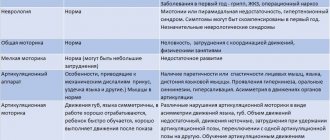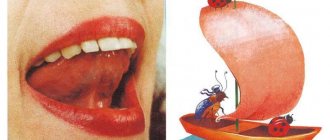Sigmatism is deficiencies in the pronunciation of whistling and hissing sounds (s, съ, з, зъ, ц, с,ж, ч, щ).
With the correct pronunciation of the sounds C, 3, C, the articulation is as follows:
- teeth are brought together at a distance of 1 mm;
- the position of the lips and the distance between the teeth depend on the subsequent vowel sound;
- the tongue is spread wide, and its tip rests on the lower incisors;
- the back of the tongue is moderately arched;
- the lateral edges of the tongue are raised and tightly pressed from the inside to the upper molars;
- a groove is formed in the middle of the wall of the tongue, through which a cold stream of exhaled air passes;
- the velum palatine (soft palate) is raised and pressed against the back wall of the pharynx, not allowing air flow through the nasal cavity;
- vocal folds are open, the sound is dull.
When pronouncing a soft sound Сь, the tongue is tense, the tip of the tongue rests much more strongly on the lower incisors, and the back of the tongue is arched and closer to the hard palate.
The articulation of voiced sounds 3-3′ differs primarily in that the sounds are voiced, because vocal folds are closed and vibrate; the back of the tongue is raised higher, the exhalation is less than with the sounds C – Сь.
The sound T is formed by the continuous and rapid pronunciation of two sounds T-S (TS - in this case T is pronounced not with the tip, but with the back of the tongue): first, the tip of the tongue rests on the lower incisors, as with C, the back is curved and touches the alveoli, then the tip of the tongue remains in the same position, and after the explosion, upon contact with the alveoli, the back lowers to the position occupied when pronouncing C, and a cold stream of air passes through the resulting groove.
The sounds Ш and Ж are hissing, when pronounced:
- lips slightly moved forward;
- the front part of the tongue in the form of a scoop is raised to the upper alveoli, but does not touch them; a gap is formed through which a warm stream of air passes;
- the lateral edges of the tongue are raised and tightly adjacent to the upper molars, not allowing air flow to pass through;
- the soft palate is raised and closes the passage into the nasal cavity;
- The vocal folds are open with Sh, and with Z they are closed and vibrate.
The sound Ш is unvoiced, and Ж is voiced.
Sounds Ch and Shch
With correct articulation, the sound CH is pronounced like TSH. First, the tip of the tongue forms a contact with the roots of the upper incisors, and then, after an explosion, it moves back to the alveoli - a strong air stream is formed. The root of the tongue is raised, approaching the hard palate. The soft palate is raised and tightly closes the passage into the nasal cavity, the vocal folds are open.
When pronouncing the sound Ш (Шь), the lips are moved forward, the tip of the tongue is raised to the alveoli; a gap is formed through which a warm air stream passes, the side edges close with the upper teeth. The tongue is tense, its root part is raised. The velum palatine closes the passage into the nasal cavity. The vocal folds are open. The sounds Ch and Sh are always dull.
Causes
Sigmatism occurs in children for various reasons. It is impossible to say exactly what was the impetus for dysfunction of the passive or active organ of the articulatory apparatus. But it is possible to identify which organ’s work disrupts phonemic harmony and correctness of speech.
The main causes of whistling and hissing sigmatism are:
- Lack of formation of articulatory praxis
- Perceptual impairments
- Disorders of the innervation of the organs of articulation
- Sensorimotor disorders
- Anomalies in the development of speech organs, jaw and dental apparatus
- Other functional disorders
- Adenoids
- Malocclusion
- Lost baby teeth
The occurrence of sigmatism can be provoked by anatomical abnormalities:
- Violations of acts of biting, swallowing, chewing
- Neuritis
- Paresis of the mouth muscles
- Bulbar palsy
In this case, the aberration is of an organic nature. The place of innervation will be the cheeks, lips, jaws, tongue, facial muscles, pharynx, larynx, motor fibers. We are talking about pathologies of the cranial nerves. They are responsible for the activity of organs and their proper functioning. To determine which of them has dysfunction, you need to undergo audiography, nystamography, and electromyography. Based on the results of the study, build further work on the correction of speech disorders.
It is necessary to resort to brain examinations only in extremely difficult situations. As a rule, a speech therapist or defectologist is able to visually identify paralysis, underdevelopment of praxis and eliminate disturbances in the functioning of the articulatory apparatus without a complex medical examination.
Symptoms
Children's speech is almost never clear right away. Violations in sound pronunciation are gradually eliminated spontaneously due to articulation practice, improving the movements of the speech organs with the age of the child. You can talk about the disease only after preschoolers reach 4 years of age.
Dysfunction can be determined by the following phonetic and physiological symptoms:
- S and Z are not pronounced clearly. Instead, similar interdental phonemes are heard with the overtones D, T, soft Sh, Zh.
Goat - pronounced as koza, scythe - kotsa, dog - tabaka, live - divut, etc.
- Whispering, ugly articulation N-W.
The tongue sticks between the teeth. The defect is visible to the eye.
- Nasal sound during phonation.
Nasal articulation is due to the immobility of the oral organs. The lips do not stretch, the tongue moves sluggishly, moves deeper into the oral cavity closer to the nasopharynx. The air stream cannot pass through the mouth and exits through the nasal opening.
- Squelching sounds during articulation.
The air stream is directed sideways. The tongue will turn to the side or rest against the teeth. Phoneme C, sibilants are pronounced with excess noise.
Corrective work in the absence of the sound Ш in speech.
Preparatory stage.
When starting to work on hissing sounds, you need to check whether the child can lift the tip of the tongue by the upper teeth and whether he can make the tongue wide (spread it). If these movements make it difficult for the child, they are practiced using special exercises.
To develop the ability to keep the tongue wide and freely spread, the child is asked to place it on the lower lip, then lightly slap his lips, as if pronouncing the sound combinations five-five-five
.
Then they develop the ability to bend the wide tongue upward in the shape of a cup. To do this, it is best to slightly stick out your wide tongue and show how its front edge can be pressed against the upper lip. If the child is unable to move, you can place the handle of a teaspoon under the tip of his tongue and, lifting it, press it to his upper lip.
Having mastered the movement, the child can repeat it with his mouth wide open, gradually moving his tongue behind his upper teeth. You need to hold your tongue suspended in your mouth, without touching the tip to the palate (see the position of the speech organs when pronouncing the sound Ш).
Sound production.
After the child learns to spread his tongue and bend it upward, the adult suggests to him: “Open your mouth slightly, lift your wide tongue over your upper teeth, like me. Now blow on your tongue. Do you hear how the wind rustled? (Air, passing through a small gap between the front edge of the tongue and the palate, forms a pinch, a pinching sound).
It happens that a child blows with the sound x
, then the jet dissipates, the sound turns out fuzzy and distorted.
In this case, he should be told: “Blow on the tip of your tongue, as if pronouncing the sound s
, but keep your tongue up.”
Developing the correct sh
requires repeated repetition and the use of various images (the wind makes noise, a snake hisses, air comes out of a burst balloon, etc.).
The game form, combined with explanation, quickly focuses the child’s attention. Gradually, under the control of an adult, he begins to perform the required movements (round his lips and slightly move them forward) and correctly pronounce the sound sh
.
It must be remembered that when introducing a sound, you should never call it to a child, so as not to cause him to habitually mispronounce it.
When the sound is delivered and pronounced correctly by the child, you can move on to automating it in syllables, words and sentences.
Types of sigmatism
The classification of sigmatisms is based on the physiology of the method of pronunciation of sounds, that is, on disturbances in the functioning of the organs of articulation. Depending on the type of dysfunction, the following types are distinguished:
- Interdental sigmatism
Signs of this type of disorder are considered to be unclear articulation of the sound “C”. It is pronounced like the English “t”. During phonation, a groove does not form in the middle of the tongue. It is necessary for the free passage of the air stream. The tongue blocks the path of the stream due to the fact that its tip is located between the jaws.
- Labiodental sigmatism
Hissing and whistling sounds are pronounced with the sound F. The reason for the manifestation of this type of sigmatism may be excessive development of the lower jaw, its protrusion forward.
The lower lip rises up to the incisors. A slight constriction is formed, and the tongue prepares to pronounce the sound S. A combined articulatory position is formed for V-F and S-Z. The phonation is mixed and unpleasant to the ear. For example, instead of lilac - firen, bunny - vfika.
- Dental sigmatism
The articulation of sibilants is disrupted by the position of the tip of the tongue. It rests on the incisors, forming a barrier to the air stream. The sound comes through a small gap, acquiring a whistle. S and Z are pronounced as T with the sound S. For example, an airplane is pronounced as a tamolet, an umbrella as a dontik.
- Hissing sigmatism
S, Z are pronounced with softening. Instead, we hear Zh, Sh. Speech is filled with noise, whistling, hissing. For example, a bag is shumka, a garden is shad, salt is zhol, winter is zhama.
Incorrect phonation is caused by the position of the tip of the tongue. It is extended towards the hard palate, curved and pulled into the oral cavity. Does not take position to pronounce S and Z.
- Lateral sigmatism
Divided into one-sided and two-sided. The tongue deviates to the side or does not touch the molars. Gaps form. An air stream passes through them, creating a squelching sound. The child speaks in place of the sound C - хьл, льь. The soup is a squelch, the dog is a squelch. Lateral sigmatism is the most complex type of disease.
- Nasal sigmatism
The air stream exits through the nose. In this way, not only whistling and hissing sounds can be pronounced, but many others. The passage of air is obstructed by the root of the tongue. It is adjacent to the posterior palate. There is no passage left for the air stream into the oral cavity. Whistling sounds are pronounced with an X sound, nasally.
Types of sigmatism can overlap with each other, forming a whole complex of speech defects. It is possible to correct violations. It is necessary to undergo examination by a speech therapist or defectologist. In particularly difficult cases, hardware research.
Characteristics of hissing sounds and their articulation.
The group of hissing sounds includes the sounds sh, zh, ch, sch
.
Sound sh
consonant, deaf, hard. There is no corresponding soft sound in the Russian language.
When pronouncing the sound sh
Normally, the speech organs take the following position:
- the lips
are slightly pushed forward;
the tip of the tongue
is raised to the palate (to the alveoli), but does not touch it, forming a gap;
the lateral edges of the tongue
are pressed from the inside to the upper molars or hard palate, without allowing a stream of exhaled air to pass along the sides.
Thus, the tongue takes the shape of a ladle or cup. the vocal cords
are open, the stream of exhaled air passes freely between them;
the air stream
is exhaled evenly in the middle of the tongue, it is strong, wide, warm, and can be easily felt with the back of the hand raised to the mouth.
Any deviation from the correct articulation pattern leads to sound distortion. When producing a sound, our main task is to create in the child the correct articulation of this sound.
Articulation of sound
differs from the articulation of the sound
sh
in the presence of a voice.
Articulation of sounds
and
ch
differs from the articulation of the sound
sh
by the additional rise of the middle part of the tongue towards the palate.
In addition, the sound h
is a closure-fissure, i.e., when it is articulated, the front part of the back of the tongue first closes with the alveoli, and then a gap is formed between them.
Thus, for hissing sounds sh, zh, shch, ch
the main one is the articulation of the sound
sh
, which means it will be basic for this group.
That is, work on correcting hissing sounds must begin with the sound w
.
If the sound w
is pronounced correctly, then by adding a voice we get the sound
w
;
by adding the rise of the middle part of the tongue, we get w
;
adding the rise of the middle part of the tongue and the bow in front of the gap, we get h
.
Therefore, violations of the sounds zh, shch, ch
are the same as those of
w
.
Correction
To eliminate articulation defects, gymnastics, breathing exercises, and logorhythmics are used. The type of violation must be taken into account. It takes more time to correct dental and lateral sigmatism than to normalize phonation in interdental and nasal sigmatism.
Articulation gymnastics
The following articulation exercises are recommended:
- Fence
We make a wide smile, teeth are visible. We fix the position of the lips for a few seconds. Then we repeat the exercise 2-3 times.
- Mustache
The child holds flat, light objects (strips of paper, tubes, pen) with his lips.
- Inflating the balloons
The cheeks are involved. The child inflates and deflates his cheeks alternately.
- Rent a pencil
The kid blows on a pencil that lies on the table.
- Imitation of chewing
- Singing syllables and sounds.
Massage
- Spot
We vibrate with our fingers under the chin, under the tragus of the ears. Open and close your mouth alternately during the massage.
- Soft palate massage
We knead the palate with our fingers until we get a pharyngeal effect.
Exercises
Tongue strengthening exercises:
- Pancakes
Licking the mouth in wide, circular movements.
- Rain
Rhythmic slaps of the tongue on the lips.
- Biting the tip, back, sides of the tongue.
Tongue spreading exercises:
- Baking pies
Mechanical assistance to the tongue will be needed. Take the tongue with two fingers and fold it into a pie.
- Sleds
- Railway
Staging sounds
During speech therapy classes on sound production [C], the imitation method, working with a mirror, and the mechanical method are used.
hissing sounds.
Before you start performing the exercises, be sure to read the recommendations for performing articulatory gymnastics.
Punish the naughty tongue.
Target.
Develop the ability to relax the muscles of the tongue and hold it wide and spread out.
Description.
Open your mouth slightly, calmly place your tongue on your lower lip and, smacking it with your lips, pronounce the sounds five-five-five... Keep your wide tongue in a calm position, with your mouth open, counting from one to five to ten.
Attention!
1.The lower lip should not be tucked in or pulled over the lower teeth. 2.The tongue should be wide, its edges touching the corners of the mouth. 3. You need to pat your tongue with your lips several times in one exhalation. Make sure that the child does not hold back the exhaled air. You can check the implementation like this: bring the cotton wool to the child’s mouth; if he does the exercise correctly, it will deviate. At the same time, this exercise promotes the development of a directed air stream.
Make your tongue broad.
Target.
Develop the ability to hold your tongue in a calm, relaxed position.
Description.
Smile, open your mouth slightly, place the wide front edge of your tongue on your lower lip.
Hold it in this position for a count of one to five to ten. Attention!
1.Do not stretch your lips into a strong smile so that there is no tension. 2.Make sure that your lower lip does not curl up. 3.Do not stick your tongue out far; it should only cover your lower lip. 4. The lateral edges of the tongue should touch the corners of the mouth.
Glue on some candy.
Target.
Strengthen the muscles of the tongue and practice lifting the tongue upward.
Description.
Place the wide tip of your tongue on your lower lip.
Place a thin piece of toffee on the very edge of your tongue and glue a piece of candy to the roof of your mouth behind your upper teeth. Attention!
1. Make sure that only the tongue works; the lower jaw must be motionless. 2.Open your mouth no wider than 1.5-2 cm. 3.If the lower jaw is involved in the movement, you can place the child’s clean index finger on the side between the molars (then it will not close the mouth). 4.The exercise must be performed at a slow pace.
Fungus.
Target.
Develop an upward lift of the tongue, stretching the hyoid ligament (frenulum).
Description.
Smile, show your teeth, open your mouth slightly and, pressing your wide tongue with its entire plane to the palate, open your mouth wide.
(The tongue will resemble a thin mushroom cap, and the stretched hyoid ligament will resemble its stem.) Attention!
1. Make sure that your lips are in a smiling position. 2.The side edges of the tongue should be pressed equally tightly - neither half should fall down. 3.When repeating the exercise, you need to open your mouth wider.
Who will kick the ball further?
Target.
Produce a smooth, long-lasting, continuous air stream running down the middle of the tongue.
Description.
Smile, place the wide front edge of your tongue on your lower lip and, as if pronouncing the sound f for a long time, blow the cotton wool onto the opposite edge of the table.
Attention!
1.The lower lip should not be pulled over the lower teeth. 2. You can’t puff out your cheeks. 3. Make sure that the child pronounces the sound f and not the sound x, that is, that the air stream is narrow and not diffuse.
Delicious jam.
Target.
Develop an upward movement of the wide front part of the tongue and a position of the tongue close to the shape of a cup, which it takes when pronouncing hissing sounds.
Description.
Open your mouth slightly and lick your upper lip with the wide front edge of your tongue, moving your tongue from top to bottom, but not from side to side.
Attention!
1. Make sure that only the tongue works, and the lower jaw does not help, does not “pull” the tongue upward - it must be motionless (you can hold it with your finger). 2. The tongue should be wide, its side edges touch the corners of the mouth. 3.If the exercise does not work, you need to return to the exercise “Punish a naughty tongue.” As soon as the tongue becomes spread out, you need to lift it up and wrap it over the upper lip.
Harmonic.
Target.
Strengthen the muscles of the tongue, stretch the hypoglossal ligament (frenulum).
Description.
Smile, open your mouth slightly, stick your tongue to the roof of your mouth and, without lowering your tongue, close and open your mouth (just as the bellows of an accordion stretch, so does the hyoid frenulum stretch).
The lips are in a smiling position. When repeating the exercise, you should try to open your mouth wider and wider and keep your tongue in the upper position longer. Attention!
1. Make sure that when you open your mouth, your lips are motionless. 2.Open and close your mouth, holding it in each position for a count of three to ten. 3. Make sure that when you open your mouth, one side of the tongue does not sag.
Focus.
Target.
Develop the ability to lift the tongue upward, the ability to shape the tongue into a ladle and direct the air stream in the middle of the tongue.
Description.
Smile, open your mouth slightly, place the wide front edge of your tongue on your upper lip so that its side edges are pressed together and there is a groove in the middle of your tongue, and blow off the cotton wool placed on the tip of your nose.
The air should go in the middle of the tongue, then the fleece will fly up. Attention!
1. Make sure that the lower jaw is motionless. 2.The lateral edges of the tongue should be pressed against the upper lip; a gap is formed in the middle into which an air stream flows. If this doesn't work, you can hold your tongue slightly. 3.The lower lip should not curl up or pull over the lower teeth.
Based on materials from the website *****
- Pronunciation of consonants
- Orthoepy. Pronunciation of combinations CHN and CHT
- The pronunciation of hissing sounds [Ш], [Ж], [Ч], [Ш] is normal
- Russian language lesson in 1st grade Topic “Pronunciation and spelling of words with combinations zhi, shi”
- Transcription icons and their pronunciation
- Formation of literary pronunciation skills among primary school students
- Formation of pronunciation in children with severe speech impairments
- An important factor in the formation of correct pronunciation is the level of development of fine motor skills
- Pronunciation in preschool children
- Pronunciation of preschool children
- The importance of muscle freedom for a choir conductor. The connection between the conductor's movements and the sound of the choir
- The tragic sound of A. Akhmatova’s poem “Requiem”
- Historical and philosophical sound of the fable “The Wolf in the Kennel”
- Modern sound of some ideas
- Sound. General characteristics
- Musical sound, music system, musical notation
- Research work “Sound can be seen!”
- Sound in the house
- Formats for recording and storing video and audio files
- Audio Compression
- Sound automation cyclogram. Speech therapy
- Sound phenomena. Physics. Lesson summary
- Physics lesson plan: Sound sources. Sound vibrations. Sound waves
- Sound commands









